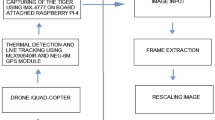Abstract
Invasive species greatly disrupt island ecosystems, risk assessment and the conservation of native ecosystems have therefore become pressing concerns. However, the cost of monitoring invasive species by humans is often high. In this study, we developed a system to detect an invasive lizard species, Anolis carolinensis, that threatens the native insect ecosystem of the Ogasawara Islands in Japan. Surveying these forest lizards requires specialized field observers, a challenge that prevents the government of Japan from efficient conservation and management of this ecosystem. The proposed system detects these lizards in drone images using a type of machine learning called deep neural network. Data were collected using a drone on Ani-jima in the Ogasawara Islands, and the trained network shows approximately 70% precision of detecting A. carolinensis. This study shows the combination of remote sensing and machine learning have the potential to contribute to an efficient and effective approach to conserving ecosystems.




Similar content being viewed by others
References
Benjamin K, Michele V, Devis T (2017) Fast animal detection in UAV images using convolutional neural networks. In: IEEE international geoscience and remote sensing symposium
Berger-Tal O, Lahoz-Monfort JJ (2018) Conservation technology: the next generation. Conserv Lett. https://doi.org/10.1111/conl.12458
Chiba S, Cowie RH (2016) Evolution and extinction of land snails on oceanic islands. Annu Rev Ecol Evol Syst 47:123–141
Davis MA (2009) Invasion biology. Oxford University Press, Oxford
Fritts TH, Rodda GH (1998) The role of introduced species in the degradation of island ecosystems: a case history of Guam. Annu Rev Ecol Syst 29:113–140
Girshick R (2015) Fast R-CNN. In: IEEE international conference on computer vision
Girshick R, Donahue J, Darrell T, Malik J (2014) Rich feature hierarchies for accurate object detection and semantic segmentation. In: IEEE conference on computer vision and pattern recognition
Hasegawa M, Kusano T, Miyashita K (1988) Range expansion of Anolis carolinensis on the Bonin Islands, Japan. Jpn J Herpetol 12(3):115–118
Hubel DH, Wiesel TN (1968) Receptive fields and functional architecture of monkey striate cortex. J Physiol 195(1):215–243
Keller RP, Lodge DM, Finnoff DC (2007) Risk assessment for invasive species produces net bioeconomic benefits. PNAS 104:203–207
Liu W, Anguelov D, Erhan D, Szegedy C, Reed S, Fu CY, Berg AC (2016) SSD: Single Shot MultiBox Detector. ECCV 2016:21–37
Maeda H, Sekimoto Y, Seto T, Kashiyama T, Omata H (2018) Road damage detection using deep neural networks with images captured through a smartphone. Comput-Aided Civ Infrastruct Eng 33:1127–1141
Norouzzadeh MS, Nguyen A, Kosmala M, Swanson A, Palmer MS, Packer C, Clune J (2018) Automatically identifying, counting, and describing wild animals in camera-trap images with deep learning. PNAS 25(115):e5716–e5725
Redmon J, Farhadi A (2016) YOLO9000: better, faster, stronger. In: IEEE conference on computer vision and pattern recognition
Ren S, He K, Girshick R, Sun J (2017) Faster R-CNN: towards real-time object detection with region proposal networks. In: IEEE transactions on pattern analysis and machine intelligence
Sax DF, Gaines SD, Brown JH (2002) Species invasions exceed extinctions on islands worldwide: a comparative study of plants and birds. Am Nat 6(160):766–783
Schiffman R (2014) Drones flying high as new tool for field biologists. Science 344(6183):459–459
Shimizu Y (2003) The nature of Ogasawara and its conservation. Glob Environ Res 7:3–14
Shinobe S, Uchida S, Mori H, Okochi I, Chiba S (2017) Declining soil Crustacea in a world heritage site caused by land nemertean. Sci Rep 7:12400
Taylor JD, Hadley ME (1970) Chromatophores and color change in the lizard, Anolis carolinensis. Zeitschrift für Zellforschung und Mikroskopische Anatomie 104:282–294
Toda M, Nakagawa N, Sukigara N (2009) Ecology and control of green anole Anolis carolinensis, invasive alien species in the Ogasawara Islands. Glob Environ (Chikyuu Kankyou) 14(1):39–46
Williamson M, Fitter A (1996) The varying success of invaders. Ecology 77:1661–1666
Yoshida K, Iijima Y, Oka S (2009) Hydroclimatic conditions that affect the subtropical dry scrub of Ani-jima Island. Res Ogasawara 35:15–58
Yoshimura M, Okochi I (2005) A decrease in endemic odonates in the Ogasawara Islands, Japan. Bull FFPRI 4(1)(394):45–51
Acknowledgements
This study was supported by nature restoration projects of The Ministry of the Environment.
Author information
Authors and Affiliations
Corresponding author
Additional information
Publisher's Note
Springer Nature remains neutral with regard to jurisdictional claims in published maps and institutional affiliations.
Electronic supplementary material
Below is the link to the electronic supplementary material.
Rights and permissions
About this article
Cite this article
Aota, T., Ashizawa, K., Mori, H. et al. Detection of Anolis carolinensis using drone images and a deep neural network: an effective tool for controlling invasive species. Biol Invasions 23, 1321–1327 (2021). https://doi.org/10.1007/s10530-020-02434-y
Received:
Accepted:
Published:
Issue Date:
DOI: https://doi.org/10.1007/s10530-020-02434-y




